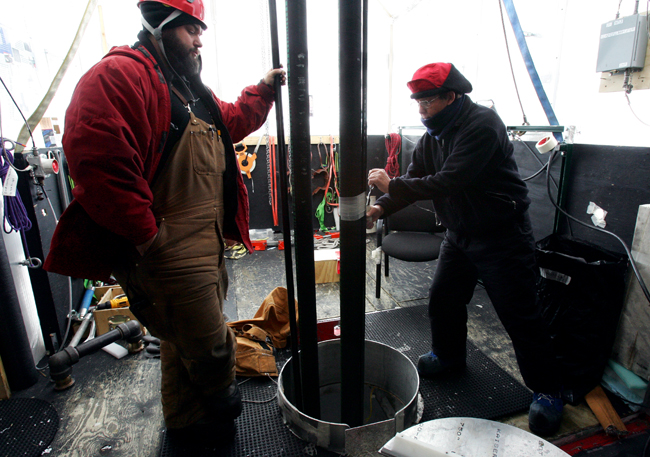
Photo Credit: Peter Rejcek |
IceCube drillers Eric "Bear" Coplin, left, and Graham Tilbury monitor an ice hole as the hotwater drill ascends. Tilbury is cutting and removing tape that fasten the hose to a cable that supports it. Each hole is about 2,500 meters deep. |
Halfway done
IceCube project drills 18 holes, begins collecting data on atmospheric neutrinos
By Peter Rejcek, Antarctic Sun Editor
Posted February 29, 2008
Construction of the world’s largest, and perhaps most unique, telescope is 50 percent complete.
More Information and Related Stories
Drillers deployed the 18th string of digital sensors for the IceCube Neutrino Observatory array on Jan. 25, 2008. That means there are now 40 strings of digital optical modules (called DOMs) buried up to 2,500 meters into the ice around the South Pole.
The goal is to bury as many as 80 such strings, each carrying 60 DOMs, within a cubic kilometer of ice.
“We’ve made excellent progress for such a large experiment,” said Albrecht Karle, a professor at the University of Wisconsin-Madison, in early January as the 13th hole was under way at the time.
The multi-million-dollar international project is a big experiment to understand one of the smallest particles in the universe — high-energy neutrinos. Neutrinos are subatomic particles with almost no mass and no electrical charge that are created by certain kinds of radioactive decay, such as what takes place in the sun or from a supernova.
As the story goes, something like a billion neutrinos will shoot right through your body by the time you finish this sentence. Oh, there goes another billion … They almost never interact with matter, traveling directly from their source, and can typically pass entirely through the Earth unobstructed. Most of them are solar neutrinos from the sun.
The international team of scientists behind IceCube is interested in understanding neutrinos from more exotic, extragalactic origins — from black holes or supernova. The sources of those neutrinos could lead to a better understanding of other brainy astrophysics concepts as cosmic rays, which are energetic particles from space.
“One of the primary goals of IceCube and high-energy neutrino astronomy is to find the origin of these high-energy particle accelerators in the universe,” Karle said. “These accelerators are quite amazing. They produce particles of energy a billion times higher than what we can generate in terrestrial laboratories.”
But perhaps the biggest prize from understanding neutrinos would be the discovery of dark matter. No one has ever captured dark matter or tasted it — let alone seen it — but most scientists are convinced that this non-luminous material exists and makes up most of the mass of the universe, clumping around visible matter. And some theories even say that neutrinos could make up at least a portion of dark matter.
(Incidentally, an equally mysterious concept called dark energy, a sort of anti-gravitational force accelerating the expansion of the universe and shaping the evolution of galaxies, actually makes up about 70 percent of the universe.)
What else could IceCube discover? Karle shrugs. “Perhaps some yet undiscovered exotic phenomena, perhaps we’ll see some fundamental laws of physics violated,” he said, seeming to relish the idea.
“IceCube is a discovery experiment, so we are doing things for the first time,” Karle noted. “We’re looking at the universe in a new way, so there’s a chance for surprises.”
IceCube doesn’t directly detect neutrinos, which travel nearly at the speed of light. Instead, like a sports photographer who captures the dynamic collision of a bat on a baseball, the detector spots the rare, head-to-head collisions between a neutrino and an atom within the ice. This subatomic car wreck creates a particle called a muon. In the transparent ice, the muon radiates a blue light that IceCube’s DOMs can detect.
The muon preserves the direction the original neutrino traveled, a cosmic breadcrumb that scientists can use to trace back to the source.
Unfortunately, for the scientists, nearly all the collisions represent neutrinos from near-Earth sources. Only a fraction will come from extra-galactic origins, hence the cubed kilometer size of the array.
1 2 Next





